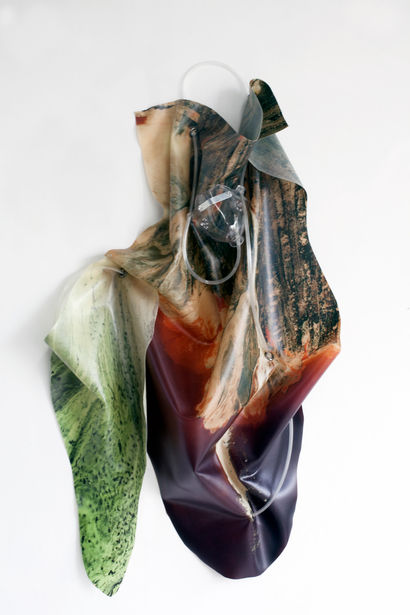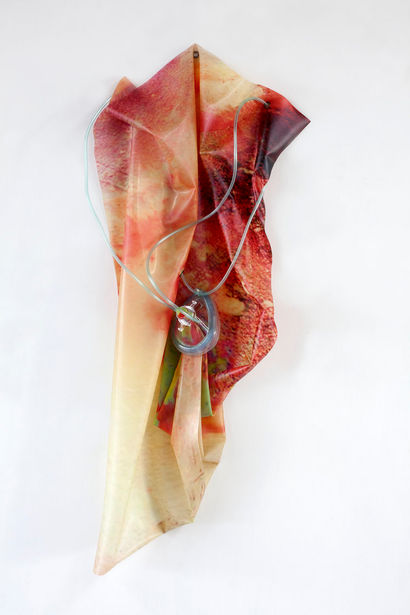Exhibition view: VARIOUS OTHERS 2020 Jan Paul Evers & Anouk Kruithof (Photo: Constanza Meléndez)
DE
Für die diesjährige Ausgabe von Various Others hat JO VAN DE LOO die Galerie von Beat Raeber aus Zürich zu Gast.
Die Galerie von Beat Raeber verfolgt neue Wege, mit Künstlern zu arbeiten: Mit Formaten von längerer Dauer, Ausstellungsprojekten im öffentlichen Raum und neuartigen Konzepten, wie Kunst heute gezeigt und der Öffentlichkeit näher gebracht werden kann. In der Gemeinschaftsausstellung werden Arbeiten von Jan Paul Evers (*1982 Köln) und Anouk Kruithof (*1981 Dordrecht, NL) gezeigt.
In seinen Werken folgt Jan Paul Evers einem erweiterten Fotografiebegriff: mit künstlerischen Arbeiten im fotografischen Verfahren erobert er den Raum, schafft ihn neu und bannt ihn schließlich auf Papier, wobei die Spur eines Objektes manchmal sichtbar bleibt, andere Male gänzlich unkenntlich wird. In Evers kontemplativen fotografischen Werken, allesamt Unikate, geht er den technischen und gestalterischen Möglichkeiten des Mediums Fotografie nach.
Anouk Kruithof verfolgt einen vielschichtigen, interdisziplinären Ansatz, der Fotografie, Skulptur, Installation, Künstlerbücher, Performance, Video und Interventionen im öffentlichen Raum umfasst.
In ihrem Werk untersucht sie die mediale Darstellung dringender sozialer Themen. Dazu sammelt die Künstlerin Bilder zu Themen wie Privatsphäre, staatliche Überwachung, Umweltverschmutzung und Klimawandel. Diese unterzieht Kruithof einer kritischen Prüfung, indem sie vorhandene Bilder aus der digitalen Sphäre extrahiert und die Fotos in ihre eigene dreidimensionale Bildsprache übersetzt.
EN
For this year’s edition of Various Others, JO VAN DE LOO hosts Beat Raeber, Galerie (Zurich). Beat Raeber, Galerie explores new ways of working with artists, ranging from long-durational formats, exhibition projects in public spaces to innovative, contemporary concepts of how art can be shown and brought closer to the public.
The collaborative exhibition showcases the work of Jan Paul Evers (*1982 Cologne) and Anouk Kruithof (*1981 Dordrecht, NL).
In his artistic practice Jan Paul Evers examines the ways in which images function, from the diverse processes by which they arise through to the ways in which they seduce observers.
Evers utilises both analougue and digital technologies in a complex and labour-intensive process that he linkens to sculpture.Through carefull edition and extraction, crafting and constructing a final unique object is formed.
Born in 1981 in Dordrecht (NL) Anouk Kruithof’s multilayered, interdisciplinary approach encompasses photography, sculpture, installation, artist books, performance and video.
Her work is an investigation into the online representation of urgent social themes. Over the past few years she collected circulating images related to issues like privacy, government surveillance, pollution and climate change. Kruithof subjects these to critical scrutiny by extracting existing imagery from the digital sphere and translating the photographs into her own idiosyncratic three-dimensional visual idiom.
Anouk Kruithof positions her sculptures Petrified Sensibilities, Skimmer and Stonewall (2017) in a world seduced by alienated images that have lost their integrity. She printed found or bought aerial photographs of environmental disasters (such as oil spills and chemical waste dumps) on latex, plastic and rubber anti- slip mats. For the series ‘Petrified Sensibilities’ Kruithof then shaped these as organ-alike sculptures out of the printed photos combined with oxygen, anaesthesia or laryngeal mask airways and tight together with oxygen tubing.
The 2 standing sculptures ’Skimmer and Stonewall’ are like dismembered synthetic bodies; smooth and sleek artificial hybrid forms unveil themselves partially.
Only casually protected with a soft adhering cover, they do not allow us to completely explore their structure. Initially barely familiar shapes actually reveal traces of human presence.By appropriating the anthropocentric visual language, she examines the human nature relationship as one entailing contamination, displacement, mutual alternation and, finally, normalization.



































